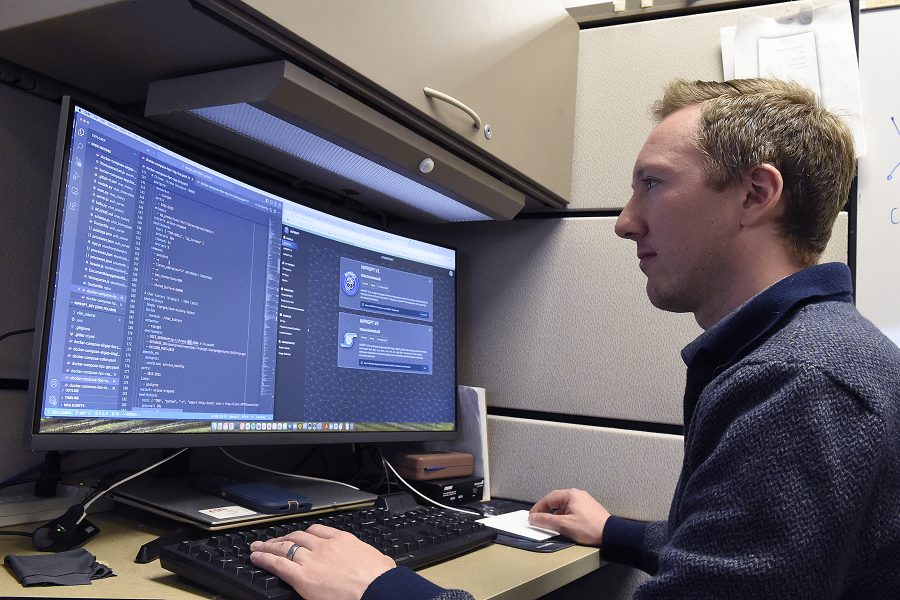Military software developers are using generative AI-powered coding assistants to help them modernize decades-old legacy codebases, officials said this week.
And the Department of the Air Force Bot Operations Team (DAFBOT), part of the Air Force Life Cycle Management Center, says it is leading the way.
AI tools to assist legacy code modernization is “probably my biggest ask for industry right now, because that is the exact problem that we’re dealing with: Trying to find more efficient, effective ways to modernize that legacy [code] faster,” said Jason Hunter, digital transformation program manager at the Forge, a Navy software factory based in Riverdale, Md.
Hunter told an audience of defense contractors at AFCEA Northern Virginia’s Innovation IT Day event April 10 that AI-powered code assistants can help modernize huge, decades-old legacy codebases in obsolete computer languages like Fortran and COBOL.
“I do have a lot of interest in bringing AI, large language models [LLMs], some of the code assistant [tools] into our environment,” he said, noting the scale of the task.
“We’ve got a couple of baselines that are anywhere from 7 million to 15 million lines [of code] that are developed over 30-plus years.”
On top of that, documentation is often incomplete or missing.
“If there are any developers in the audience, or if you work with developers, you know: Sometimes they comment code well, sometimes that doesn’t happen. Sometimes there’s documentation. Sometimes … not,” said Hunter.
DOD Chief Software Officer Rob Vietmeyer told Air & Space Forces Magazine on the sidelines of the event that these legacy systems have become “a boat anchor,” a huge drag on the department’s innovation efforts. He said AI-powered code assistant tools could “help us decompose some of these monolithic legacy architectures” and rebuild the code using modern IT architectures like microservices.
Code assistant tools use large language models (LLMs) to generate computer code, in the same way LLM-powered chatbots like ChatGPT generate human language.
These tools enable so-called low code or no code software development, where normal English instructions from the user are translated into computer language by the chatbot. Low/no code tools are widely available in the commercial marketplace, but the process of recreating one codebase in a different computer language, known as refactoring, is a different challenge.
The Department of the Air Force Bot Operations Team (DAFBOT), announced this week that they had successfully refactored applications originally written in obsolete COBOL into Java using LLMs.
It is a process DAFBOT Chief Technology Officer Jude Stanley compared in a statement to taking a document originally written in a combination of Sanskrit and Mandarin and translating it, first into Latin and then into English.
“The challenge lies in ensuring that the English version conveys the same narrative as the original combined text, capturing all its nuances. Legacy code bases are highly customized and unique to their capabilities,” said Stanley.
The military faces particular challenges because of security concerns about LLMs, which typically hoover up data to train themselves and their successors and may require specialized chips and other hardware to run, because of their massive computing demand.
“What has been a struggle for us is that our code sits in a classified environment where … we have some limits and constraints from what type of hardware is necessarily available with that. So we’re looking at a couple of different models to bring in some things to pilot and investigate here over the next year,” Hunter said of the Navy software factory The Forge.
“Maybe AI can help us modernize our legacy systems,” added Ana Kreiensieck, software modernization lead in the Department of Defense CIO’s office. “But legacy systems, that’s a complex situation, right? And it requires some governance and some decision-making.”
For example, how much of the old system had to be preserved? How much could safely be modernized? A step-by-step approach, even to AI-powered transformation, might be best, she suggested.
“We’ve seen success,” Kreiensieck said, “with that strangler fig pattern where you take it piece by piece, until you modernize the [whole] system.”
